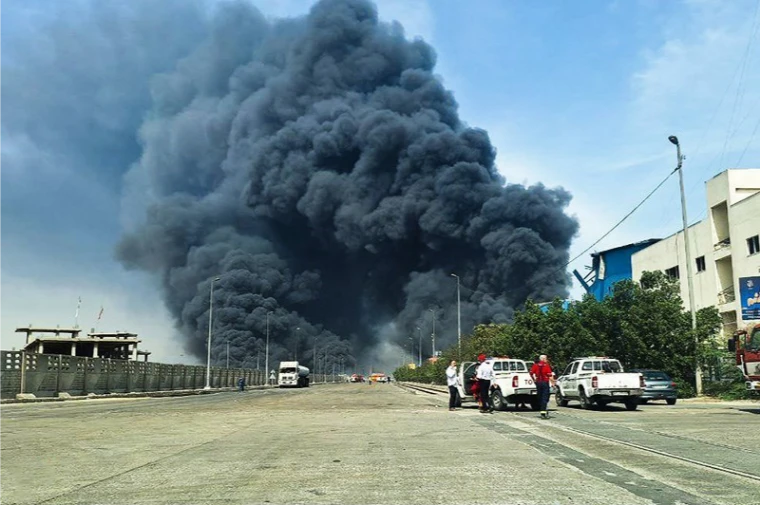On April 26, a catastrophic explosion followed by a raging fire tore through the Shahid Rajaee port near Bandar Abbas, Iran’s largest commercial port and a critical hub for maritime trade. The incident, which occurred at approximately 12:05 Iranian Standard Time, has left a trail of destruction, with the death toll rising to at least 46 and over 1,200 people injured, according to state media reports. The blast, potentially linked to a chemical used in missile propellant, has sparked widespread concern, prompted a national investigation, and disrupted Iran’s trade operations.
The explosion originated in the Sina container yard within the Shahid Rajaee port, a facility handling approximately 80 million tons of goods annually and accounting for 85–90% of Iran’s container traffic. Videos verified by international media, including the BBC, showed a fire with reddish-hued smoke intensifying before a massive detonation. The shockwave shattered windows, damaged buildings kilometers away, and was felt as far as Qeshm Island, 26 kilometers south of Bandar Abbas. At least one building collapsed, and debris littered the port area, complicating rescue efforts.
State media reported that the blast was likely caused by a stockpile of hazardous chemicals, with some sources pointing to sodium perchlorate, a key ingredient in solid fuel for ballistic missiles. The Associated Press, citing British security firm Ambrey, noted that the port had received a shipment of sodium perchlorate in March 2025, potentially enough to propel 260 mid-range missiles. However, Iranian authorities have not confirmed these claims, and the exact cause remains under investigation.
The human toll has been consequential. Among the injured were three Chinese nationals, according to China’s state broadcaster CCTV. The Iranian Red Crescent Society dispatched rapid response teams, and helicopters poured water on the blaze, which continued to burn into Sunday night. Emergency services evacuated the injured to hospitals in Bandar Abbas and as far as Shiraz and Tehran. Pir Hossein Kolivand, head of Iran’s Red Crescent, reported that 190 of the injured remained hospitalized by Sunday
Iranian authorities acted swiftly to address the crisis. President Masoud Pezeshkian visited Bandar Abbas on April 27, meeting with emergency personnel and victims. “We have to find out why it happened,” he said during a televised meeting with officials, emphasizing the need for a comprehensive investigation to prevent future incidents. The governor of Hormozgan province, Mohammad Ashouri, declared three days of mourning, and a national day of mourning was set for April 28.
The explosion prompted a state of emergency in Bandar Abbas, with schools and offices closed on April 27 due to choking smoke and air pollution. The Ministry of Health advised residents to stay indoors and wear protective masks. Russia contributed to the response by sending a firefighting aircraft and personnel to assist in extinguishing the blaze, which was 90% contained by Sunday afternoon, according to the Iranian Red Crescent.
Port operations were suspended, halting a significant portion of Iran’s trade. The Shahid Rajaee port, located on the strategic Strait of Hormuz, handles 55% of Iran’s total trade and is vital for the country’s economy. The closure has raised concerns about disruptions to supply chains and oil exports, though the National Iranian Oil Refining and Distribution Company confirmed that its refineries, fuel tanks, and pipelines were unaffected.
The explosion’s timing, coinciding with a third round of nuclear talks between Iran and the United States in Oman, has fueled speculation. Iranian Foreign Minister Abbas Araghchi noted that security services were on high alert due to past instances of sabotage, though no senior official has suggested the blast was an attack. Beni Sabti, an expert at the Institute for National Security Studies, told Maariv that the port’s proximity to Islamic Revolutionary Guard Corps (IRGC) facilities, used for weapons transfers and oil smuggling, underscores its strategic importance. However, he cautioned that it was too early to determine whether the incident was accidental or deliberate.
Hossein Zafari, a spokesperson for Iran’s crisis management organization, attributed the blast to poor storage of chemicals, noting prior warnings about safety risks at the port. This aligns with a history of industrial accidents in Iran, often linked to aging infrastructure and sanctions-related maintenance challenges. For instance, a 2023 explosion at Bandar Abbas’ oil refinery killed one worker, and similar incidents have occurred at other facilities.
Some experts have drawn parallels to the 2020 Beirut port explosion, caused by poorly stored ammonium nitrate. Andrea Sella, a chemistry professor at University College London, suggested that ammonium nitrate could explain the Bandar Abbas blast’s scale, though sodium perchlorate remains a focal point of investigation.
The explosion has significant economic and geopolitical ramifications. The temporary closure of Shahid Rajaee port could strain Iran’s trade-dependent economy, particularly its oil exports, which are critical for foreign currency earnings. The incident also highlights vulnerabilities in Iran’s infrastructure, raising questions about safety protocols and oversight at strategic facilities.
Geopolitically, the blast occurs amid heightened tensions in the Middle East. Iran’s ongoing nuclear negotiations with the United States, mediated by Oman, aim to curb Tehran’s nuclear program. While no evidence links the explosion to these talks, the incident underscores the challenges Iran faces in maintaining stability during sensitive diplomatic engagements. Past incidents attributed to Israel, including cyberattacks and strikes on Iranian nuclear and missile sites, have heightened Tehran’s vigilance, though Israel’s military has not commented on this event.
As firefighters work to fully extinguish the blaze and investigators probe the cause, the focus remains on supporting the victims and restoring port operations. The Iranian government’s response, including President Pezeshkian’s call for a thorough investigation, signals a commitment to addressing the incident’s root causes. However, the scale of the disaster and its impact on Iran’s trade hub will likely reverberate for months, if not years.
The Bandar Abbas explosion serves as a stark reminder of the risks associated with handling hazardous materials and the need for robust safety measures. As Iran navigates the aftermath, the international community watches closely, aware of the delicate balance between domestic stability and regional dynamics.
